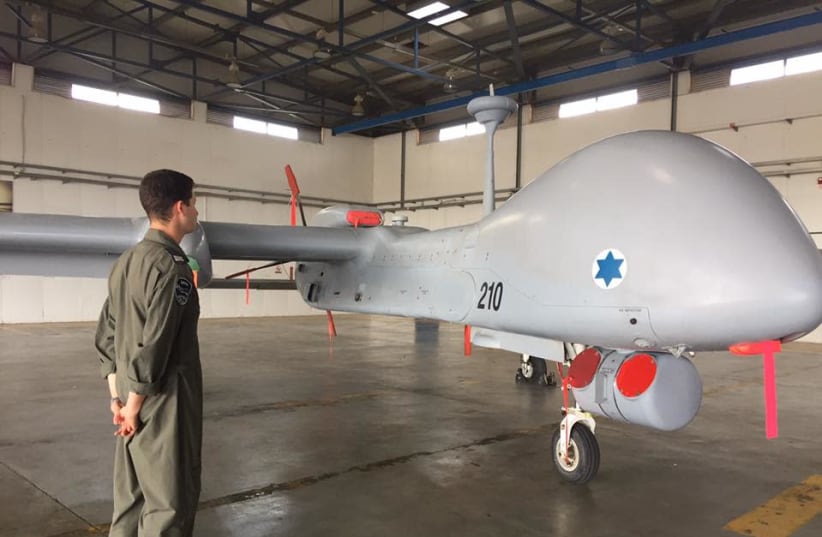As drone warfare makes the headlines for the use of unmanned vehicles by Russia in Ukraine, 12 German pilots have landed in Israel to take part in a course to operate Berlin’s newest Heron TP UAV.
The German pilots are training at Tel Nof Airbase in central Israel with the Israel Air Force’s Red Baron squadron. Named after German World War I ace Manfred Albrecht Freiherr von Richthofen, it is the only IAF squadron that permanently works with a non-Israeli one.
It was opened in 2018 and will be training German teams until 2027. The training of the German pilots in Israel marks the first time that Germany has had a constant deployment in Israel or any non-NATO state.
Though several German teams have come to Israel to learn how to operate the drones flown by the IAF, known as the Eitan, this is the second course where the Germans are learning to fly their own drones.
The course opened as German Member of Parliament Johannes Arlt from the Social Democratic Party (SPD) proposed to use the new UAVs to protect German critical infrastructure from any possible future Russian threat.
Though the drones were initially purchased to be used abroad, "due to Russian threats, we must quickly create the legal basis that will allow the use of these UAVs for national security purposes,” Arlt told Der Spiegel.
"Due to Russian threats, we must quickly create the legal basis that will allow the use of these UAVs for national security purposes.”
German Member of Parliament Johannes Arlt

Germany currently does not allow for UAVs to fly in its airspace, but according to reports in German media, the Israeli-made drones will be deployed to Schleswig in northern Germany in the second half of 2023.
The Germans have been flying the Heron 1 since 2009 when it first received the UAVs manufactured by Israel Aerospace Industries and has used them extensively in Mali and Afghanistan.
In 2018, the German and Israeli defense ministries signed a nine-year agreement to lease seven Heron-TPs as well as the training, operational support, and maintenance throughout the term of the agreement.
Last April, the Bundestag announced that the drones would be equipped with Israeli missiles, despite the use of armed UAVs being a politically divisive issue in Germany.
Germany increased its defense budget
Following Russia’s invasion of Ukraine, Germany increased its defense budget to two percent of the GDP and said it would set up a special fund of €100 billion ($108b.) in order to swiftly upgrade its armed forces.
As part of that, Reuters reported that the German Air Force will reportedly get €40b., €27b. of which will be spent on upgrading command and control capabilities. In addition, the army will get €17b. and the navy will receive €10b.
It is understood that Israel will play a key role in helping Germany’s force buildup. Israel, known for years as a leader in drone technology, has sold hundreds of platforms to militaries around the world.
While the international press has reported the use of attack drones by the Israeli Air Force for at least the past 20 years and has been extensively documented in US diplomatic cables as well as at international airshows, the IDF never publicly disclosed the use of such platforms until July when the military censor finally allowed journalists to publish their use.
Over the past decade, the operational use of drones by airforces around the world and by the IAF has increased drastically, with almost every operation now seeing the use of these platforms.
The IAF has 10 different UAV platform types and seven operational drone squadrons.
The Heron TP "Eitan"
The Eitan, known around the world as Heron TP, is the Israel Air Force’s workhorse. Designed as a multi-mission platform with numerous payload configurations, it can perform a variety of missions including intelligence gathering, surveillance, target acquisition, and more.
Equipped with satellite data link and electro-optical infrared sensors, the Eitan is able to not only provide reconnaissance to ground forces in combat situations but able to create movement profiles and attack targets.
It is equipped with automatic taxi-takeoff and landing systems (ATOL), satellite communication (SATCOM) for extended range, fully redundant avionics and more. The drone, which is 15 meters long and with a 26-meter wingspan, also has satellite communications for Beyond Line of Sight Range missions.
With an endurance of over 30 hours, the Eitan is capable of flying distances of up to 1,000km at a maximum altitude of 40,000 feet while relaying precise information makes it a likely option in the event that Israel decides to carry out strikes against targets in enemy countries.
The Eitan saw combat action during Operation Cast Lead in 2008 even before it was formally absorbed by the IAF, was used extensively during Operation Protective Edge in Gaza in 2014 and the numerous rounds of violence in the Hamas-run enclave since.
